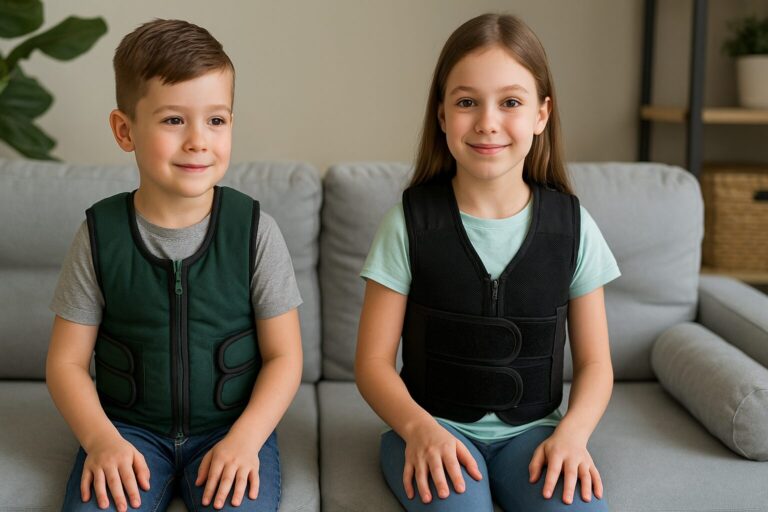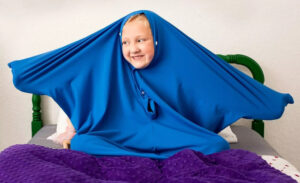Why Weighted Vests Work
The gentle, consistent pressure from a weighted vest stimulates the proprioceptive system—the sensory system responsible for body awareness. Activating this system can have a soothing effect and help regulate emotions and attention. Therapists often recommend starting with a vest that weighs about 5–10 percent of the user’s body weight (always consult an occupational therapist for individual guidelines) and wearing it for short periods (15–30 minutes) as part of a sensory diet.
Benefits & Uses
- Calming transitions: Weighted vests can ease anxiety during busy periods like morning routines or classroom transitions.
- Improved focus: Many users experience better concentration and reduced restlessness during homework, reading, or therapy sessions.
- Body awareness: Deep pressure helps the wearer sense their body in space, which may improve coordination and posture.
- Portable and discreet: Compression vests are lightweight and can be worn under clothing without drawing attention.
Best Weighted Vests on Amazon
Below are three highly‑rated weighted vests that sensory professionals and parents love.
Harkla Weighted Vest for (Kids)
Tried and true, this adjustable vest is made from soft neoprene and features removable weights so you can customize the pressure level. Extra weights are available to purchase and you can really make these as heavy as you need them. Parents and therapists praise its comfy fit and durable construction. Many reviewers report noticeable improvements in attention and reduced fidgeting during homework or classroom time.
Fun & Function Weighted Compression Vest (Kids and Adults)
Designed by occupational therapists, this vest offers both compression and removable weights. It comes in sizes for toddlers through adults and features sturdy Velcro closures. Reviews note its versatility for sensory diets and its straightforward machine‑washable design.
Fun & Function Fleece Weighted Vest
Ideal for discreet wearing, this normal fleece vest uses distributed weight pockets on bottom panel for customizing to the ideal weight. Caregivers report that it helps kids feel calmer in crowded environments and can be worn discretely. Comes with 2 pounds of weights and is machine washable.
Choosing the Right Vest
- Fit & adjustability: Look for vests with adjustable straps or Velcro panels so you can get a secure yet comfortable fit.
- Removable weights: The ability to add or remove weight lets you tailor pressure levels to different activities.
- Breathable materials: Soft fabrics like neoprene or cotton blends are more comfortable and can help prevent overheating.
- Weight guidelines: As a general rule, choose a vest that weighs about 5–10 % of body weight and start with shorter wear sessions (15–30 minutes).
Do Adults Need Separate Weighted Vests?
Weighted vests are widely used for children, but many adults also benefit from deep-pressure input for focus and emotional regulation. Most children’s vests max out at about 20–25 lbs body weight. Adults should choose vests sized appropriately for their chest circumference and with enough weight capacity (5–10 % of their body weight). Our picks above include options for both kids and adults; always check sizing charts and consult a professional if unsure.
Tips for Safe Use
- Consult an occupational therapist before starting a weighted vest regimen.
- Never exceed 10 % of the wearer’s body weight without professional guidance.
- Limit wear time to 20–30 minutes at a time, followed by a break.
- Monitor the wearer’s comfort; remove the vest if they show signs of discomfort or overheating.
Explore More Sensory Tools
Weighted vests pair nicely with other deep‑pressure tools like weighted blankets, body socks, or compression clothing. Combine them with movement tools such as therapy balls or balance boards for a comprehensive sensory diet.
Frequently Asked Questions
How heavy should a weighted vest be?
Occupational therapists usually recommend vests weigh between 5 % and 10 % of the user’s body weight. Always consult a professional to determine the right weight range.
Can I leave a weighted vest on all day?
No. Weighted vests are meant for short sessions—typically 15–30 minutes—followed by a break. Prolonged wear could cause muscle fatigue or discomfort.
Do weighted vests help with sleep?
Weighted vests should not be worn during sleep. Consider a weighted blanket instead for nighttime deep pressure.
What sizes are available?
Most weighted vests come in sizes from toddler through adult. Check manufacturer sizing charts for chest and waist measurements before ordering.



